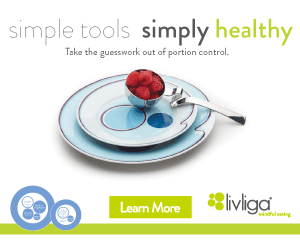1. Choose colors in your kitchen and where you eat that are calming and non-triggering. Think about color in the kitchen and where you eat. Color influences our mood. It is important that we pay attention to the colors we use in our lives, especially around food. Think blues and greens rather than reds and oranges.
2. Trim down your dinnerware. Assess the size of your tableware. Measure your bowls and plates. Dinner plates should not be larger than 10 inches. More importantly the well of the plate should not be larger that 7 inches. All plates should have rims. Bowls should hold no more than 14 ounces. Ideally you want a bowl just large enough to accommodate 1½ cups for servings of foods like soup, pasta and certain cereals with milk. (Check out Livliga dinnerware for what right-sized looks like.)
3. Make the first thing you see in your kitchen something healthy. Studies show we tend to pick the first thing we see so strategically placing a healthy food will help us choose better. A bowl of fruit is an easy visual that is also visually appealing. This is also true in your refrigerator…put the healthy foods in the front of each shelf.
4. Drink out of glassware that makes measuring 8 ounces easy. If we drink out of a large glass we are going to drink large amounts of whatever beverage is in our glass. This might not be an issue if it is water but the problem is we use the same glass for everything we drink. Our eyes automatically adjust to whatever size we live with. If we use large glasses we will over serve ourselves every time. Right sizing our glassware allows us to right size what we consume and gives our eyes an ability to adjust to right-sized servings. (Click here to see what right-sized glassware looks like.)
5. Hide trigger foods and make them difficult to get to. We make over 200 decisions a day about the food we eat. A lot of those decisions are about what we will or won’t eat. Most of the time it is about resisting tempting foods we see. Hide them from our visual field and you don’t have to keep looping that decision making to resist eating something we really don’t want to eat. “Out of sight, out of mind” is true.
6. Serve food away from the table where you eat. It is easier and psychologically helpful to serve up in the kitchen. Foods sitting on the table while you eat are too accessible and trigger us to think we want seconds. Put as much food as possible away as you are serving up, or portion it into storage containers, so it is ready for another meal for another time and not visible from your table.
7. Set an attractive table and sit down to eat. Attractiveness has a powerful affect on our sense of satisfaction. Placemats frame your plate allowing the plate and the food on it to look attractive and appealing. Setting the table and sitting down to eat both help us be mindful that we are eating a meal. We can enjoy the moment and process of eating which contributes to our sense of feeling full and satisfied at the end of a meal.
8. Scale down your food. Bring smaller amounts into your house and repackage your food into 1, 2 or 4 servings before putting it away so it fits with how your are preparing and serving your food.

















No comments